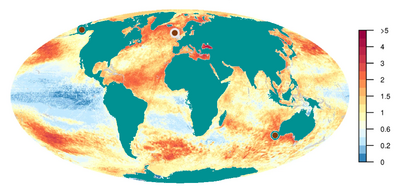
Back الأثر البشري على الحياة البحرية Arabic پر سمندري ژوند د انسان اغېزې Pashto/Pushto Tác động của con người đối với đời sống dưới nước Vietnamese 人類對海洋生物的影響 Chinese

| Part of a series of overviews on |
| Marine life |
|---|
 |
Human activities affect marine life and marine habitats through overfishing, habitat loss, the introduction of invasive species, ocean pollution, ocean acidification and ocean warming. These impact marine ecosystems and food webs and may result in consequences as yet unrecognised for the biodiversity and continuation of marine life forms.[3]
The ocean can be described as the world's largest ecosystem and it is home for many species of marine life. Different activities carried out and caused by human beings such as global warming, ocean acidification, and pollution affect marine life and its habitats. For the past 50 years, more than 90 percent of global warming resulting from human activity has been absorbed into the ocean. This results in the rise of ocean temperatures and ocean acidification which is harmful to many fish species and causes damage to habitats such as coral.[4] With coral producing materials such as carbonate rock and calcareous sediment, this creates a unique and valuable ecosystem not only providing food/homes for marine creatures but also having many benefits for humans too. Ocean acidification caused by rising levels of carbon dioxide leads to coral bleaching where the rates of calcification is lowered affecting coral growth.[5] Additionally, another issue caused by humans which impacts marine life is marine plastic pollution, which poses a threat to marine life.[6] According to the IPCC (2019), since 1950 "many marine species across various groups have undergone shifts in geographical range and seasonal activities in response to ocean warming, sea ice change and biogeochemical changes, such as oxygen loss, to their habitats."[7]
It has been estimated only 13% of the ocean area remains as wilderness, mostly in open ocean areas rather than along the coast.[8]
- ^ Halpern, B. S., Frazier, M., Afflerbach, J. et al. (2019) "Recent pace of change in human impact on the world’s ocean." Scientific Reports, 9: 11609. doi:10.1038/s41598-019-47201-9.
- ^ Halpern, B. S., Walbridge, S., Selkoe, K. A., Kappel, C. V., Micheli, F., D'agrosa, C., Bruno, J. F., Casey, K. S., Ebert, C., Fox, H. E. and Fujita, R. (2008) "A global map of human impact on marine ecosystems". Science, 319(5865): 948–952. doi:10.1126/science.1149345.
- ^ Human impacts on marine ecosystems Archived 22 October 2019 at the Wayback Machine. GEOMAR Helmholtz Centre for Ocean Research. Retrieved 22 October 2019.
- ^ "5 ways that climate change affects the ocean". www.conservation.org. Retrieved 9 December 2022.
- ^ Kawahata, Hodaka; Fujita, Kazuhiko; Iguchi, Akira; Inoue, Mayuri; Iwasaki, Shinya; Kuroyanagi, Azumi; Maeda, Ayumi; Manaka, Takuya; Moriya, Kazuyoshi; Takagi, Haruka; Toyofuku, Takashi; Yoshimura, Toshihiro; Suzuki, Atsushi (17 January 2019). "Perspective on the response of marine calcifiers to global warming and ocean acidification—Behavior of corals and foraminifera in a high CO2 world "hot house"". Progress in Earth and Planetary Science. 6 (1): 5. doi:10.1186/s40645-018-0239-9. ISSN 2197-4284.
- ^ Villarrubia-Gómez, Patricia; Cornell, Sarah E.; Fabres, Joan (1 October 2018). "Marine plastic pollution as a planetary boundary threat – The drifting piece in the sustainability puzzle". Marine Policy. 96: 213–220. doi:10.1016/j.marpol.2017.11.035. ISSN 0308-597X.
- ^ Special Report on the Ocean and Cryosphere in a Changing Climate (SROCC). IPCC (Report). 25 September 2019. p. 2. Retrieved 25 March 2020.
- ^ Jones, K. R., Klein, C. J., Halpern, B. S., Venter, O., Grantham, H., Kuempel, C. D., Shumway, N., Friedlander, A. M., Possingham, H. P. and Watson, J. E. (2018) "The location and protection status of Earth’s diminishing marine wilderness". Current Biology, 28(15): 2506–2512. doi:10.1016/j.cub.2018.06.010.
© MMXXIII Rich X Search. We shall prevail. All rights reserved. Rich X Search